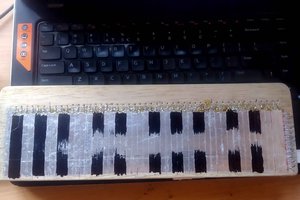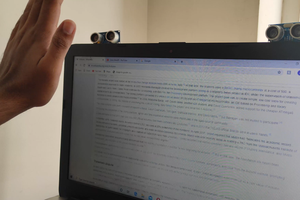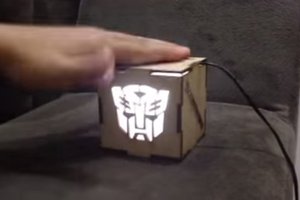Distance-sensing glasses
Glasses that warn the user when walking towards an obstacle via sound.
Glasses that warn the user when walking towards an obstacle via sound.
To make the experience fit your profile, pick a username and tell us what interests you.
We found and based on your interests.
20180614_111550.jpgFinished prototypeJPEG Image - 4.23 MB - 06/14/2018 at 09:34 |
|
|
essai3.inoArduino programino - 1.81 kB - 06/14/2018 at 09:06 |
|
|
We’ve continued to create programs for the distance sensor on Arduino. We’ve met some problems : the first problem was that there were issues with our programs. The next one was that we think there is a problem with the USB cable we got when we ordered our powerpack. We tried to change our connections, but it still wasn’t working. We are sure that our program for the distance sensor is working.
We have found a program for a buzzer on Arduino. We need to find how to adapt it for using two buzzers. If we find it, we’ll have to change the program because we would like both tone buzzers to change in function of the distance of an obstacle.
At home we also had to solder everything, wires with wires and wires with our Arduino.
We’ve received our powerpack and found some piezo buzzers. We’ve tried to create some programs for the distance sensor on Arduino. We’ve also searched how to connect the piezo buzzers to the arduino. Overall, we tried to link the different programs together.
Program used for the distance sensor;
https://codebender.cc/sketch:356078#HC-SR04%20Ultrasonic%20Sensor%20Example.ino
http://www.instructables.com/id/How-to-use-a-Buzzer-Arduino-Tutorial/
We started writing the part of the program related to the distance sensor and we connected the sensor to the arduino. After looking for a way to connect the gyroscope to the arduino, we decided we wouldn’t be using it anymore (it is not possible to connect both the distance sensor and the gyroscope to an Arduino Pro Micro, as it is too small).
We also thought about small changes we could make to improve the glasses. The only one we found to be realistic was changing the tone of the sound emitted depending on the distance separating the user from the obstacle.
But overall, we spend most of the session looking for programs, again, because the ones we found before weren’t adapted to our project.
We started this class by drawing a prototype of the glasses, to help us visualise the placement of each component. We then searched for ways to connect earphones to an arduino, and how we could send sound through these earphones using the arduino. We realised that using earphones would require much more components, such as many resistors. Using more components is complicated for this project, because everything has to fit on the glasses’ frame without bothering the person wearing them.
We decided to use piezo buzzers instead, which will allow the sound signal to be heard by other people (not only the person wearing the glasses). It might be less practical but it is easier to build.
We also soldered pins to the arduino; as we can’t use a breadboard for this project (due to space limitations), we will be soldering every pieces with each other.
We informed ourselves on how to use a piezo buzzer, and we searched for different programs we then compared to each other.
We didn’t receive many components we ordered yet, so we spend the rest of the session experimenting with the Arduino Pro Micro. We had never used it before, so we needed to get used to it.
https://programmingelectronics.com/an-easy-way-to-make-noise-with-arduino-using-tone/
During the session, we mostly informed ourselves as much as we could on the OxSight project and projects alike to find how exactly it did work, and how we could actually build it without many expensive materials and advanced knowledge in engineering.
We settled on the following idea: a pair of glasses which uses sensor to detect nearby obstacles (in the direction where the user is looking) and then emits a sound to inform the user of said obstacles. We highly simplified the idea of the OxSight project because we know we wouldn’t be able to use LED screens and such.
We made a list with all the different pieces and materials we thought we would need. We tried to find cheap components, on websites such as Amazon. There wasn’t much we could do without the components, so we spend the time which was left on researching diverse arduino programs that might come in handy for this project.
https://github.com/bbkbarbar/Arduino-HC-SR04-library
https://letmeknow.fr/blog/2013/10/15/tuto-detecteur-de-presence/
Monday, March 26th - Introduction
During this session, we had to find a SDG-related problem we wanted to try solving. In our group, we first looked at every Sustainable Development Goal on the United Nations website and started eliminating those who didn’t spark any ideas in our minds. While talking about the kind of problems we wanted to solve, we agreed on making something to help disabled people (specifically blind and visually-impaired people). We then searched for different projects that already existed to help us find more precises ideas. The projects which caught our attention the most were:
http://www.assisted-vision.com/home
http://www.tuvie.com/voice-stick-portable-text-scanning-device-for-the-visually-impaired/
We hesitated between the last two. The first one wasn’t that much appealing to us compared to the others because it is already pretty cheap. We first settled on a scanning device which could scan an entire mass-market paperback book page at once and translate it into braille through a small board; but then we realised that it would take way to much time and resources than we have. Ultimately, we decided to look for a way to make enhanced glasses with less resources and less electronic-building skills.
First, you need to design your glasses : which shape, what colors ? You also need to know where to fix your components on your glasses
After you have your design, you need to look for which components you need. You'll need an Arduino, wires, a power bank and buzzers
Once you have everything you need, you'll have to look for programs and adapt them for your need if necessary. You'll also have to look for circuit
Create an account to leave a comment. Already have an account? Log In.
Become a member to follow this project and never miss any updates



 Marcelo Cuin
Marcelo Cuin
 Saxx
Saxx